"Analysis and Conservation of Cultural Heritage Monuments: Challenges and Approaches Across Disciplines"
Wednesday, March 30, 2016
3 p.m.–6:30 p.m.
Rush Rhees Library, Welles-Brown Room
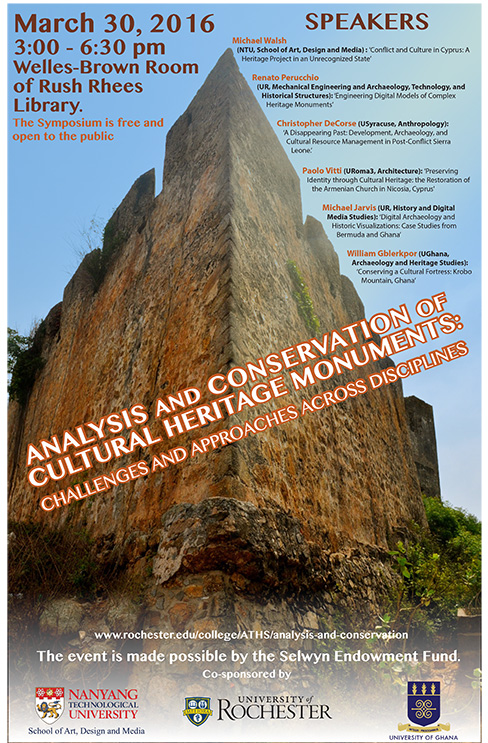
This event is made possible by the Selwyn Endowment Fund and co-sponsored by Nanyang Technological University, University of Rochester, and University of Ghana.
Organizer:
Renato Perucchio, Professor of Mechanical Engineering
Director of the Program in Archaeology, Technology, and Historical Structures
University of Rochester
Overview
The symposium consists of presentations by international scholars in the humanities, social sciences, and applied sciences on interconnected issues related to the analysis and conservation of cultural heritage monuments across the globe.
Our purpose is to discuss current challenges and present approaches stressing the inherent multidisciplinary nature of the field as well as the international connections between institutions needed to develop successful conservation programs.
This event continues and expands themes introduced in the symposium on 3D DIGITAL ARCHAEOLOGY: RECONSTRUCTION, ANALYSIS, AND CONSERVATION OF CULTURAL HERITAGE held at the University of Rochester on December 4, 2013. Like its precursor, the present symposium will foster the interdisciplinary dialog necessary for the development of innovative and potentially far-reaching multidisciplinary approaches to the conservation of heritage monuments.
Program
3:00 – 3:10 | Opening remarks |
3:10 – 3:40 | Michael Walsh, Conflict and Culture in Cyprus: A Heritage Project in an Unrecognized State. |
3:40 – 4:10 | Renato Perucchio, Engineering Digital Models of Complex Heritage Monuments. |
4:10 – 4:40 | Christopher DeCorse, A Disappearing Past: Development, Archaeology, and Cultural Resource Management in Post-Conflict Sierra Leone. |
4:40 – 5:00 | Refreshments Break |
5:00 – 5:30 | Paolo Vitti, Preserving Identity through Cultural Heritage: the Restoration of the Armenian Church in Nicosia, Cyprus. |
5:30 – 6:00 | Michael Jarvis, Digital Archaeology and Historic Visualizations: Case Studies from Bermuda and Ghana. |
6:00 – 6:30 | William Gblerkpor, Conserving a Cultural Fortress: Krobo Mountain, Ghana. |
Speakers
Michael Walsh, School of Art, Design and Media
Nanyang Technical University, Singapore
Renato Perucchio, Department of Mechanical Engineering
University of Rochester
Christopher DeCorse, Department of Anthropology
The Maxwell School of Citizenship and Public Affairs, Syracuse University
Paolo Vitti, Department of Architecture
University Roma 3, Rome, Italy
Michael Jarvis, Department of History
University of Rochester
William Gblerkpor, Department of Archaeology and Heritage Studies
University of Ghana, Legon, Ghana
ABSTRACTS
Michael Walsh
Conflict and Culture in Cyprus: A Heritage Project in an Unrecognized State
The political impasse that Famagusta’s heritage has found itself in for something close to four decades as a result of the ‘Cyprus Problem’ is well known. My presentation suggests an alternative route to education and intervention through the advance of technology and the use of NGOs. In particular I look at a pilot project I direct in Famagusta, conducted in partnership between the local municipality, the World Monuments Fund and Nanyang Technological University (Singapore) to: Document endangered heritage; Develop techniques for visualization and conservation; Create 3D modeling, GPS mapping, data recognition and visualization methods to recreate historic spaces in a scholarly manner; and Refine educational methodologies for inculcating the importance of cultural heritage in children while promoting tolerance. Lastly, and in remaining faithful to the holistic approach necessary for a complex understanding of Famagusta’s remains, I will shed light on the creation of an animated film pertaining to its art history and invite discussion on projected research into the Medieval music of Famagusta so that our accurately depicted visualizations of the historic structures and paintings need no longer remain mute.
Renato Perucchio
Engineering Digital Models of Complex Heritage Monuments
The physical conservation of heritage monuments begins with an exhaustive diagnostic process aiming at evaluating the state of the structure so that the necessary interventions and maintenance protocols can be established. In the case of complex masonry buildings, the structural assessment requires a combination of detailed historical information, visual inspections, and experimental tests both in situ and in the laboratory leading to the creation of digital models for numerical structural analysis. Despite substantial progress in research, predictive modeling of heritage structures remains a challenging task due to the difficulties of representing the mechanical behavior of typical masonry construction material such as adobe, stone, bricks, and unreinforced concrete. This paper presents the results of preliminary numerical analyses conducted by the Engineering & Heritage international research team for assessing the structural damage and the seismic vulnerability of two heritage monuments in Perú: the Saint Peter Apostle church of Andahuaylillas, Cuzco (late 16th or early 17th century), and the Moche pyramid at Huaca de la Luna, Trujillo (100 AD to 650 AD). The extension of this work to the European Trade Castles and Forts of Ghana (1482 to the 18th century) will also be discussed.
Christopher DeCorse
A Disappearing Past: Development, Archaeology, and Cultural Resource Management in Post-Conflict Sierra Leone
Sierra Leone’s cultural heritage is rapidly disappearing. The nation’s post-independence period has been tumultuous; decades of economic stagnation that culminated with a horrendous civil war between 1991 and 2002. Barely emerging from the vestiges of this conflict, the nation then faced an Ebola outbreak, which remains a concern. Not surprisingly, in this wider context, attention to the management of cultural resources in Sierra Leone has been minimal. The Sierra Leone Monuments and Relics Commission, the governmental institution charged with management of the nation’s cultural resources, has had very limited governmental support. There are no Sierra Leoneans with relevant post-graduate training in archaeology, cultural resource management, or heritage preservation. Yet the nation’s cultural resources speak vibrantly to Sierra Leone’s past, as well as Africa’s intersection with the wider Atlantic World, including the histories of Britain and the United States. Current efforts to revise the nation’s cultural resource management legislation, a revamping of the Monuments and Relics Commission, and ongoing work by Syracuse University has focused on assessing and preserving Bunce Island, Sierra Leone’s first national Historic Site. A recently completed General Management Plan provides a framework for the effective management of cultural resources on the island. The hope is that these efforts will ultimately provide a framework for the management of other cultural resources in Sierra Leone.
Paolo Vitti
Preserving Identity through Cultural Heritage: the Restoration of the Armenian Church in Nicosia, Cyprus
The United Nations Development Program (UNDP), with funding from the US Agency for International Development (USAID), has been supporting a range of peace-building projects in Cyprus since 1998. Restoring the island’s cultural heritage has been an important dimension of this effort. The aim was not only to conserve buildings and sites, but also to provide Cypriots with the opportunity to reconnect with their common heritage.. The restoration of the Armenian Church and Monastery complex in the Arabahmet neighborhood of Nicosia is one example of this initiative. This project was begun in a crucial time in the process of finding a settlement for the Cyprus issue, when the potential of cultural heritage initiatives to help heal the wounds of the past and to build trust among Cyprus’ communities became realistic. The main objective was twofold: on one side to recover one of the masterpieces of gothic architecture in Cyprus, on the other to involve the multiple stakeholders in the planning and design, in order to respect the communities’ memories of the site. Additional objectives were to guarantee the highest quality in the design of the intervention, and to bring and spread knowhow and restoration concepts and practices that were far from being applied on the north side of the island. On the basis of this it was possible for the first time since 1974 to have a restoration project shared by the Armenian, Turkish and Greek communities in Cyprus.
Michael Jarvis
Digital Archaeology and Historic Visualizations: Case Studies from Bermuda and Ghana
The work of digitally recording and modeling historic structures is important and considerable, but this data has great value beyond informing conservation strategies and policy. My paper considers logical further development of digital archaeological data to help the public better understand and value the past through interactive visualizations that help us understand the evolution of structures over time. Using examples from coastal Ghana and St. George’s, Bermuda, I will outline how, when combined with close structural analysis, we can use 3D capture from reality (using photogrammetry and laser scanning) and digital modeling to digitally restore modern and lost buildings to earlier appearances. By constructing series of iterations across time, we can better appreciate the impact of architectural trends (such as the shift from vernacular to Georgian/Palladian style in Bermuda) or nationally specific fortification strategies in the case of Ghanaian coastal castles, which not infrequently changed hands among European slave trading powers. By harnessing the power of videogame engines and virtual reality, we hope to immersively transport visitors into the past to see and study structures and whole towns in earlier states – the better to appreciate and protect them today.
William Gblerkpor
Conserving a Cultural Fortress: Krobo Mountain, Ghana
Located in southeastern Ghana, the Krobo Mountain archaeological site boasts of impressive features such as stone palaces, stone terrace walls, stone buildings, burial mounds, shrines, and ceremonial compounds. The site also has several unique geological features, including caves, rock shelters, boulders, and rock platforms, which were associated with past ritual and ceremonial activities such as puberty rites and dance performances. The site was home to the ancestor of the Krobo, who lived there between the mid-thirteenth and late-nineteenth centuries AD. In this presentation, I will discuss the preliminary results of our recent pedestrian and aerial survey, as well as excavation at the site. I will also discuss our assessment and conservation plans for some of the major archaeological and geological features at the site, including a stone palace and a burial mound located on top of the mountain. The relevance of the Krobo Mountain to the descendant community, and the overall heritage conservation goals of the Ghana Museums and Monuments Board will be discussed.
Figures
 | 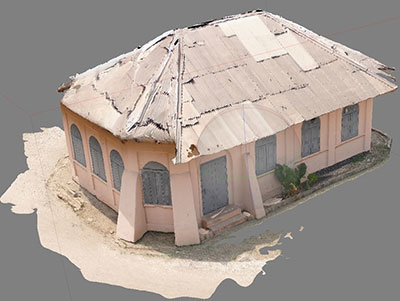 | 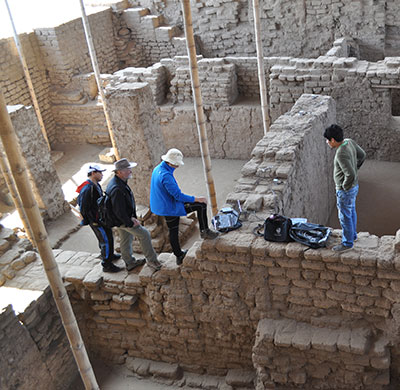 |
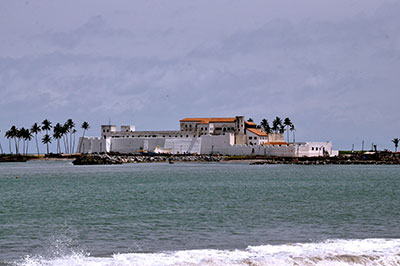 | 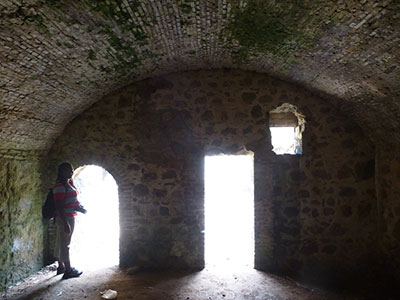 | 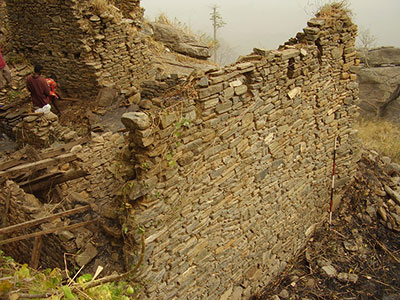 |
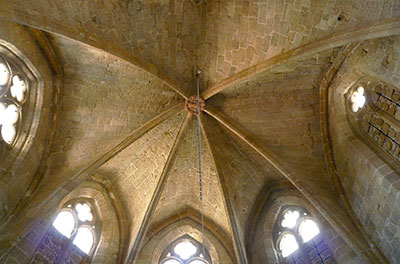 | 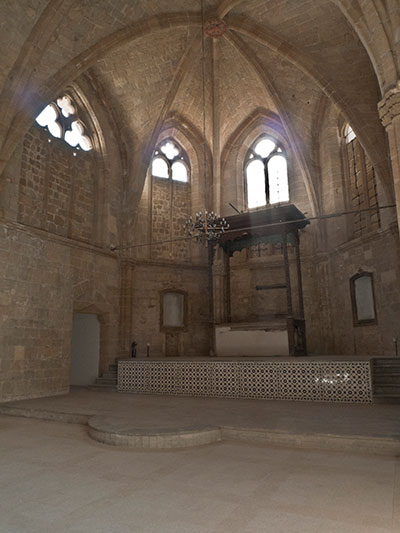 | 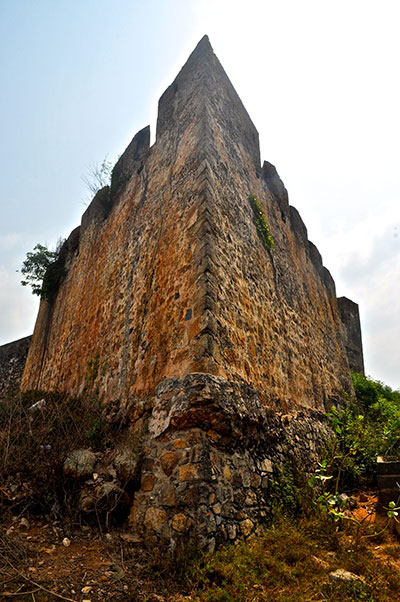 |
